From the explosion of period art, to serving as an activist platform in the menstrual movement and educating about different period issues, social media has played a crucial role in normalizing conversations around periods.
Social media is heavily ingrained into our daily lives. From the launch of the first social networks (remember the MySpace days?) to today, usage and even dependence on social media has increased ever more. Now, according to statistics gathered by Backlinko, about 4 billion people on Earth are active on social networks, that’s half of the world’s population! This number has tripled over the last decade. The average Gen Z or millennial has over 8 social media accounts, and people spend around 2.5 hours (at least!) on social media daily.
For many, a social network is the first thing we look at when we wake up in the morning and the last thing our eyes see before going to sleep. Unsurprisingly, since the outbreak of the COVID-19 pandemic, usage has increased even more as people stuck inside used these networks as a way to stay connected with the outside world.
The incredible thing about art on social media is its ability to spark conversations that we otherwise may not know how to initiate
Undoubtedly, social media has had and will continue to have a large impact on our lives. These spaces are far more than just platforms for sharing viral memes and videos, social media is a powerful force integral to shaping public dialogue. Social media serves as an influential medium for affecting public policy, says the UN, and is one way that messages are disseminated throughout society. It’s no surprise that social networks have also played a key role in opening up conversations around menstruation and reducing period stigma.
Why is it important to talk about periods?
Even today, period stigma still exists in many corners of the globe. When we don’t talk about periods openly and honestly, it reinforces the stigma and silence that has surrounded menstruation since the beginning of time. It’s important to be aware of the history of period taboos and their consequences for society because our shared menstrual past impacts our society today in many ways.
Not talking about periods is largely due to how menstruation has been treated as dirty and disgusting throughout the ages and continues to contribute to a lack of education around the topic. The danger of not knowing about menstrual care and health can lead to poor hygiene and problems like cervical cancer and reproductive diseases. There are also many products that target vaginal cleanliness such as douching or perfumed pads. These products can also be damaging to vaginal health and are typically a money grab as the vagina is a self-cleaning machine that typically does not need much maintenance!
Over time, period stigma led to the creation of menstrual etiquette, a set of unspoken rules that all menstruators should follow to hide their periods from society.
But now, times are changing. Research has shown that today’s young people don’t feel as ashamed about their periods as the generations that came before. Previously thought of as a curse, periods are finally being celebrated in society. Practicing period positivity has become widespread, and people are more willing to both talk about and show periods openly. This huge shift in attitude has been partially made possible by the explosion of conversations around periods on social media.
As Chris Bobel and Elizabeth Kissling wrote in an essay for the Women’s Studies journal in 2011, “Menstruation matters. And so do the ways we talk about it, write about it, and illustrate it.”
As periods have been discussed and visually represented in a more positive manner, societal perception of periods have changed.
How has social media helped normalize menstruation?
Social media has created a space to speak openly about menstruation, where there previously was none. No longer do we have to whisper discreetly in the privacy of the bathroom, asking a fellow menstruator for a tampon. These conversations are broadcasted publicly for all to see and hear via digital networks.
Rare mentions of menstruation in traditional media outlets previously weren’t all that kind towards periods nor the people having them. Lauren Rosewarne’s 2012 book, Periods in Pop culture, Menstruation in Film and Television, raised concerns about Hollywood’s treatment of menstruation and whether it’s frightening girls into believing it’s worse than the reality. Scenes from Carrie (1976) or Superbad (2007) that mention menstruation inspired shock and horror at the thought of seeing or touching period blood. And a sex scene in the Fifty Shade of Grey movie (2015) that features Christian removing Anastasia’s tampon was removed by the film producers from the final cut.
In recent years, there have been more positive mentions of periods on the screen. And in 2018 and 2019, movies about periods even won awards at the Oscars!
While there may still be some censorship of periods on various social platforms, much progress has been made lately. We’ve come a long way since Instagram famously deleted Rupi Kaur’s bleeding photo back in 2015. When people first started posting about periods on social media 6 years ago, there was a strongly negative response from many.
For example, also in 2015, now known as the “Year of the Period”, then Temple University student Louelle Denor posted a photo of her holding her full menstrual cup to Instagram. Several people commented telling her to kill herself. Others threatened to spray her with sperm and set her on fire. That’s how disgusted and offended they were that she would dare show her period blood to the world. She later took screenshots of these violently negative comments and published them in another post. She said, “This is what happens when you post a picture of #blood and say that it’s from your #vagina”. The extreme reaction she received showed her that she did the exact right thing, that society needed to be shown her blood, she told Huffington Post.
Since then, periods have gone viral across social media platforms. There have been a variety of trending hashtags on Twitter, like #Tweetyourperiod, #Periodsarenotaninsult, #Justatampon, #Freethetampon, #Ifmenhadperiods, #Happytobleed, to name a few. These inspired people to join the conversation and tweet about their periods. In response to Trump’s derogatory comments about menstruation and women in general, genius artist Sarah Levy drew this beautiful portrait of Donald made from her own period blood, which she calls “Bloody Trump”. It’s definitely the nicest picture of my now (thankfully!) ex-president I’ve ever seen.
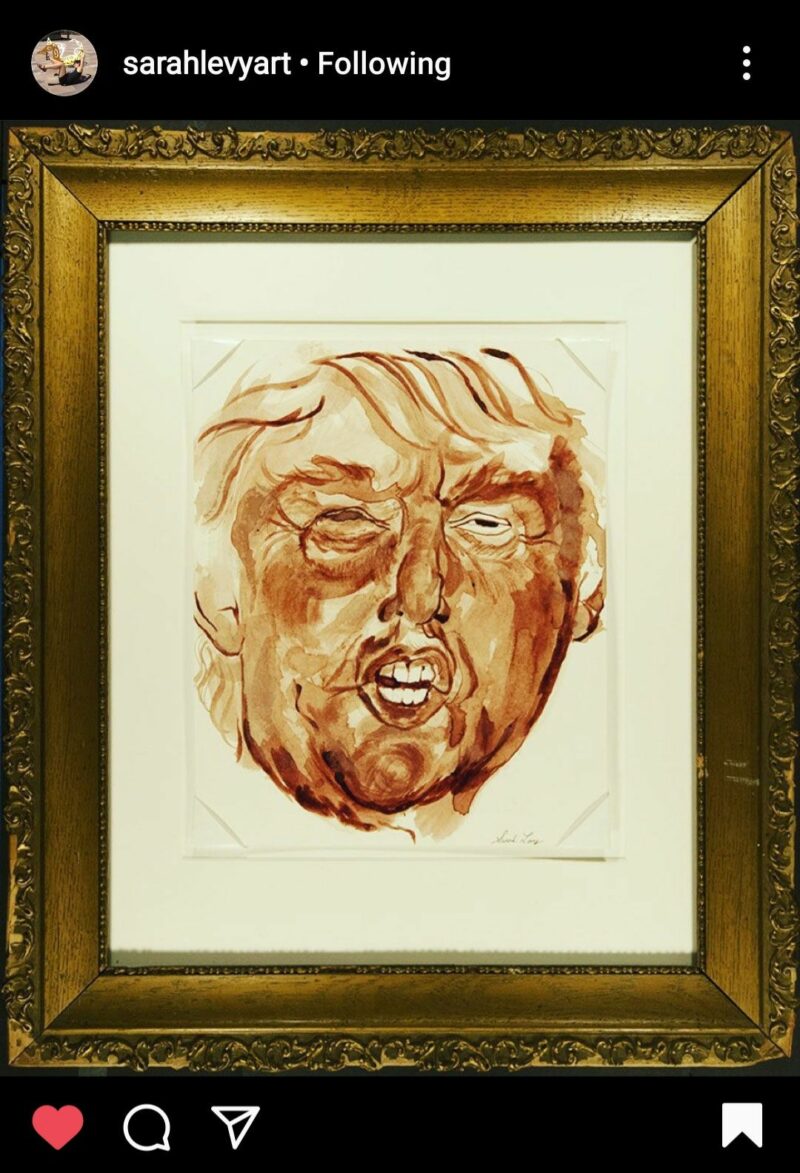
Photo credit: @sarahlevyart
Sarah Akinterinwa is a freelance digital artist and cartoonist for The New Yorker who also creates illustrations about menstruation and the female body for social media. She says,
“The incredible thing about art on social media is its ability to spark conversations that we otherwise may not know how to initiate. Half the population have or will have a period, so it's time to talk about periods in its entirety. The good, the bad and the ugly. We need to see more blood, more vaginas and more bodies that menstruate. When periods are portrayed in art, it invites us to look, laugh, relate, and ask questions. By doing so, it is no longer a taboo, but in fact a very normal function of the female body.”
Check out Sarah’s work on her website.
7 ways social media has reduced period stigma:
-
Creating a safe space for education and combating cultural taboos
Menstrual taboos have been found in all regions and cultures in the world. In some countries such as in India, Nepal, or Arab nations, they are even more pronounced, imposing restrictions on what menstruators are and aren’t allowed to do while on their periods. Social media has opened up a safe space to talk about periods and educate menstruators of all ages, regardless of geography, religious affiliations, or family.
For instance, two Arab women, Dr. Deemah Salem, from Dubai, and doula Nour Emam, from Egypt, run Instagram accounts on women’s health. They use the platform to educate people about sexual and reproductive health topics. @dr.deemahsalem is on a mission to debunk myths around women’s health that can lead to harmful practices. Doula Nour Emam, @thisismotherbeing, has become a rather polarizing figure in Egypt for what she shares on her Instagram channel. But she carries on educating women about their rights when it comes to their place in society, health and maternity care. They are both encouraging women to bring up questions about reproductive health with their doctors, as conservative cultural norms in the region may make some uncomfortable talking about it with their healthcare provider. A lack of education about health can lead to a variety of problems, like unintended pregnancy, STDs, and recurring vaginal infections, among other mental and physical health issues.
India is another country that holds strong cultural taboos when it comes to menstruation, banning women from entering the kitchen, touching foods, or entering places of worship while bleeding. The Period Song by Giliyapa on YouTube has over 6.5 million views and pokes fun at the strong menstrual taboos in India: “They won’t let you enter the kitchen or the temple...Join the Sisterhood, it’s the Red Club yo!”
Lastly, artistic representations of period blood have contributed to reducing shame and disgust surrounding monthly menstruation.
This art sends a strong message that no, contrary to what dominant discourse may have had us believe for years upon years, we are not disgusting because we bleed monthly from our vaginas. Here are a few examples:
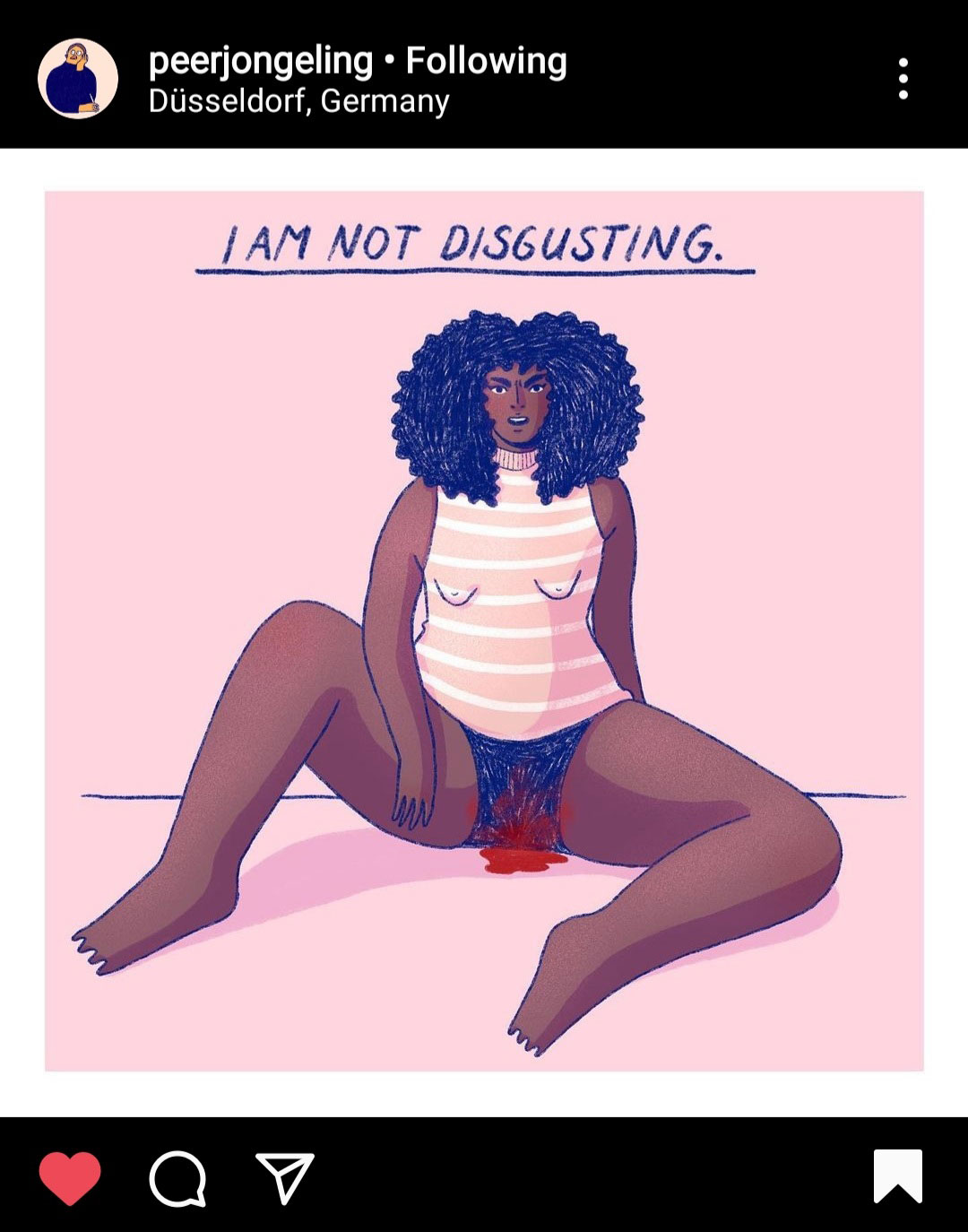
Photo credit: @peerjongeling
I especially love the below graphic posted by the menstrual product company, Freda, showing a woman flashing her period products as if they were some sort of illegal drug. It pokes fun at “tampon smuggling”, or how we tuck away our tampons and pads while on our way to the bathroom at work or in public to hide from others that we are menstruating. This is one of the practices of menstrual etiquette.
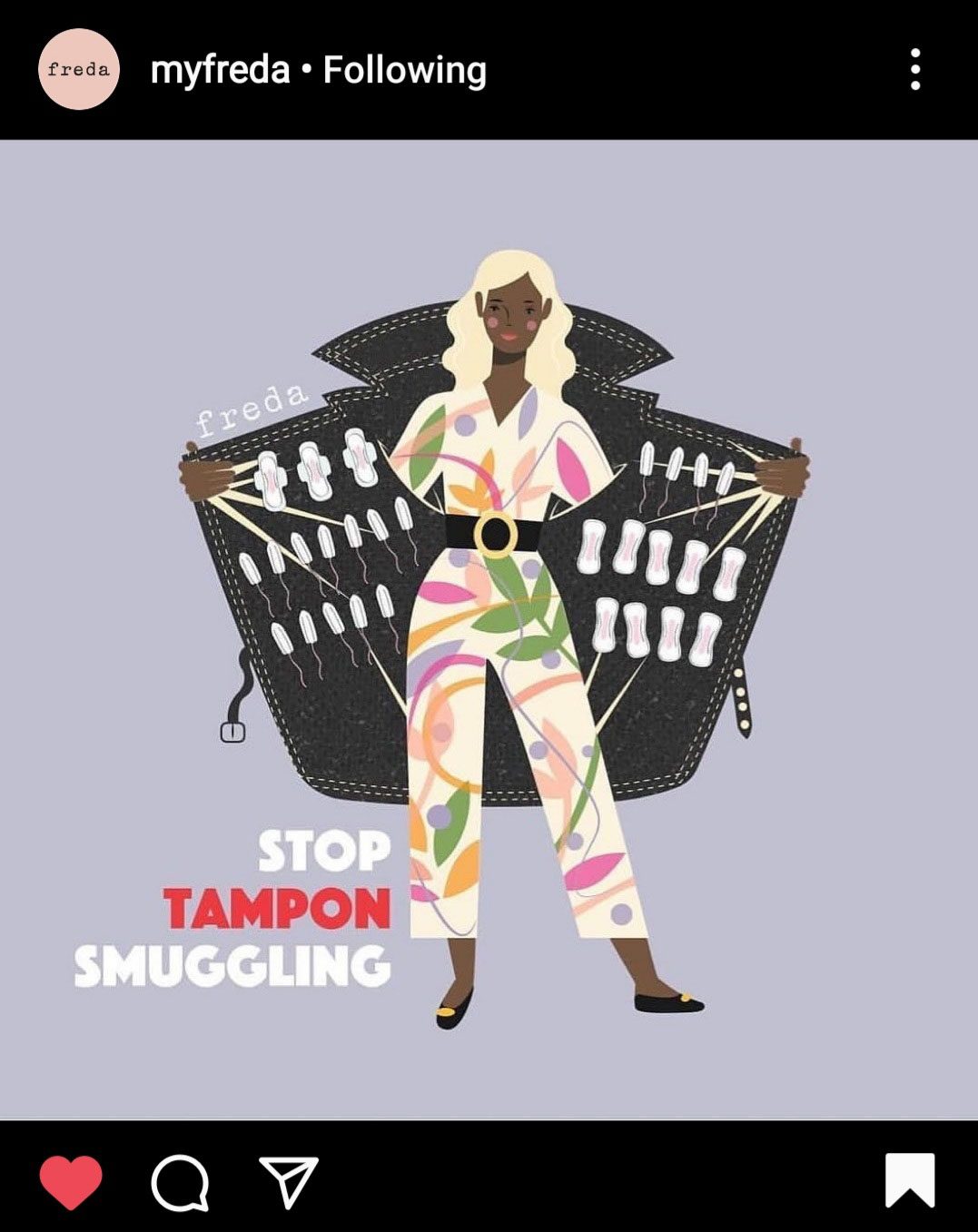
Photo credit: @myfreda
And finally this one, inspired by Rupi Kaur’s bleeding photo in bed, states point blankly that in fact, “It’s only blood”, so no need to panic, folks.
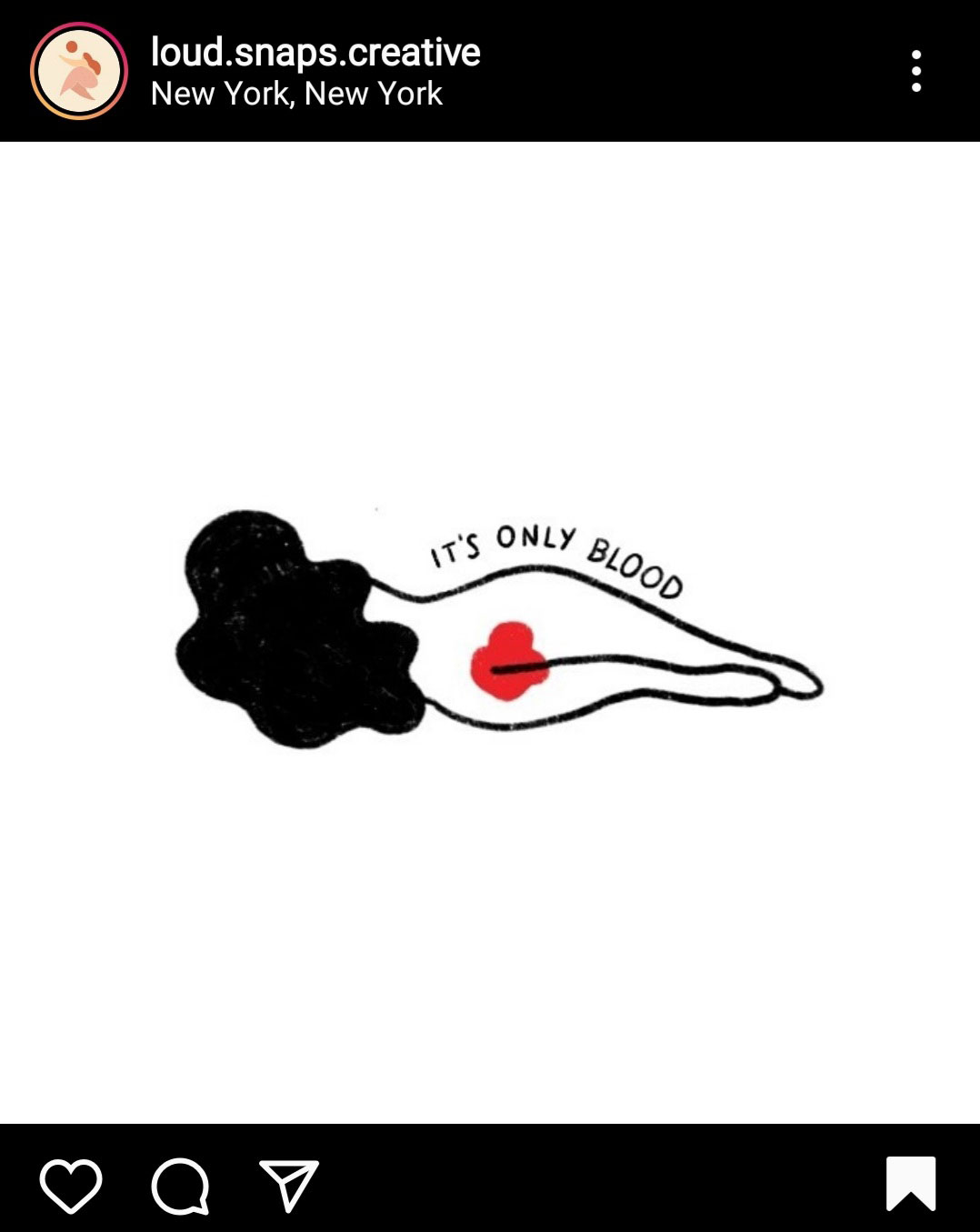
Photo credit: @loud.snaps.creative
2. Acting as a platform for the menstrual activism movement
Social media has been absolutely instrumental for the menstrual activism movement. It’s served as a space for menstruators to come together to discuss political issues such as abolishing the tampon tax in countries spanning the globe.
The long campaign in the UK against the tampon tax was partially mobilized by social media through The Pink Protest with their weekly Instagram series: “On Wednesdays We Wear Pink and Protest”. It highlighted one action each week that people can do to start their mission as an activist. They proudly claim in their bio, “We changed two laws”.
Social media showed us that being an activist isn’t just about holding a sign and protesting. There are many ways you can take a stand, and showing your support by posting about it on social media is one powerful way to do so.
3. Building up a gallery of artistic creativity, find the beauty in the blood!
Art about periods and even with periods (by using the blood) has completely exploded on social networks. Today, there are over 11.5 thousand posts on Instagram with the #periodart!
Seeing posts like the below images hammers in a new narrative into public consciousness that periods are not only normal and natural, but can also be beautiful.
Jasmine Alicia Carter is one of many amazing creatives using her own period blood to create works of art. I absolutely love her mandalas.
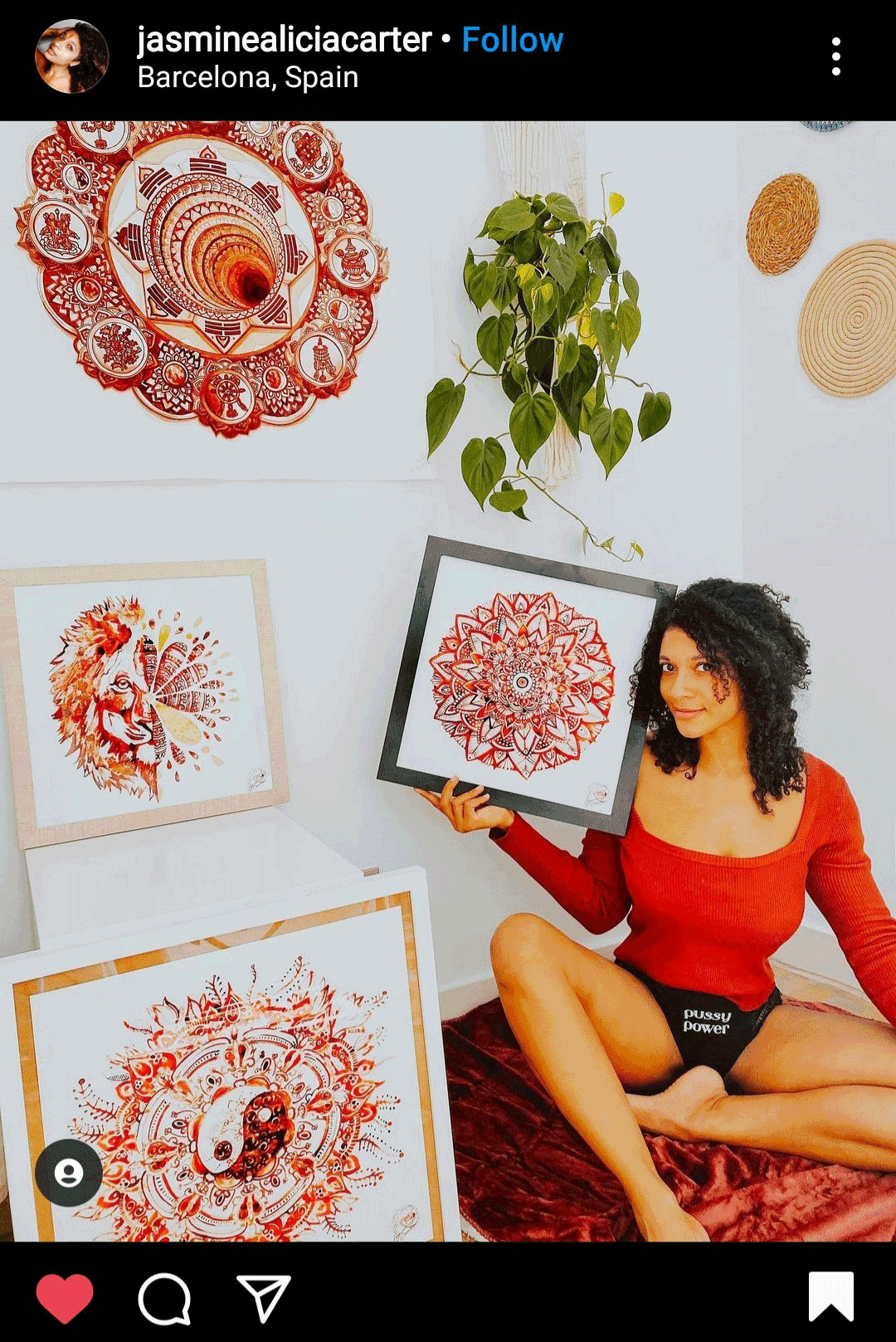
Photo credit: @jasminealiciacarter
4. Raising awareness and sensitivity around trans periods
As periods are being talked about more and more in society, there have been an increasing number of conversations about the fact that not only women experience periods, and not all women menstruate.
Cass Clemmer, aka The Period Prince, is a trans period activist and helped open up the discussion around other genders who menstruate when posting this photo:
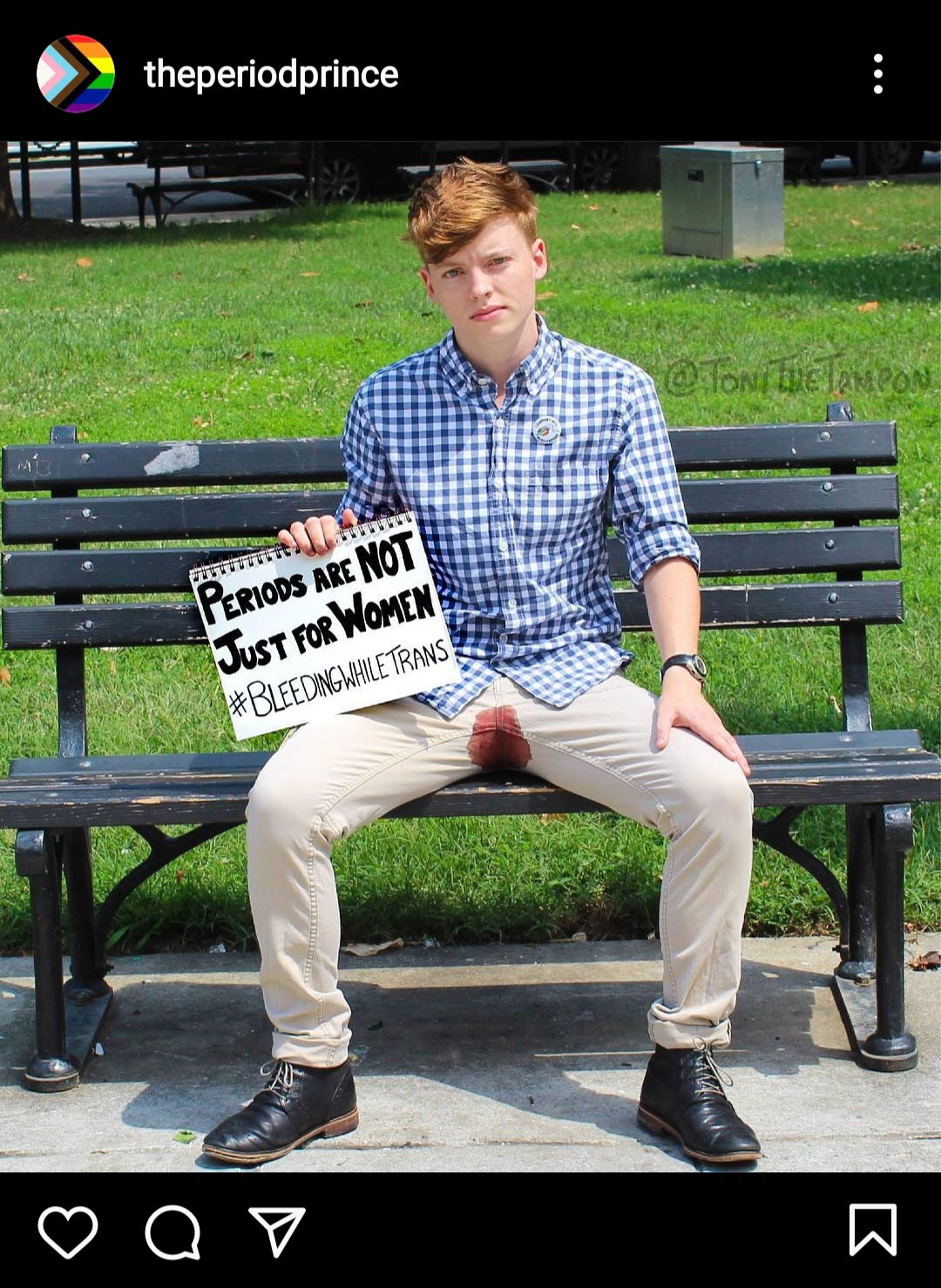
Photo credit: @theperiodprince
Art like this one below by Caitlin Blunnie, aka Liberal Jane, educates about the gender diversity in menstruation. People from all areas of the gender spectrum can experience periods.
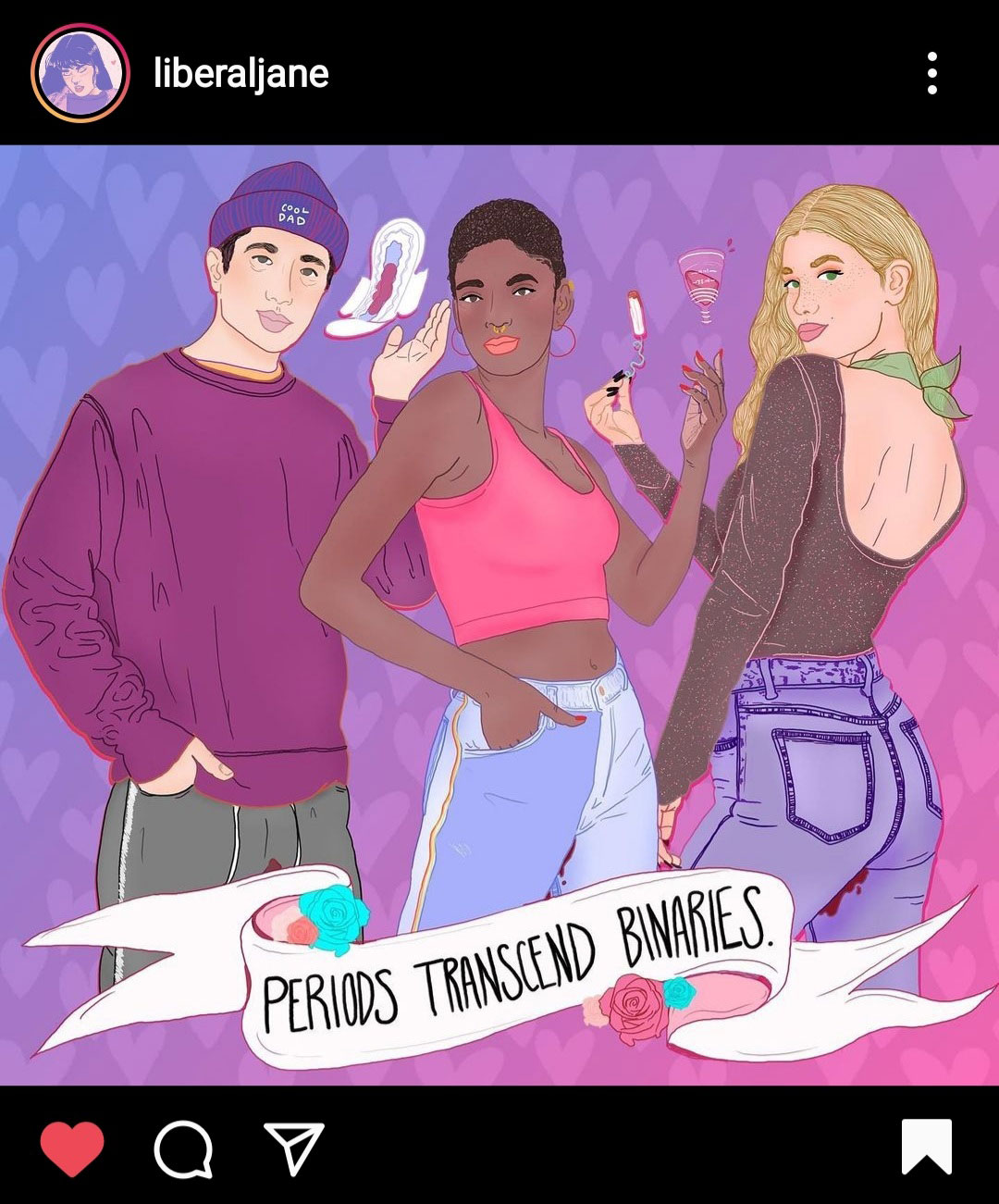
5. Teaching men about periods
In July 2020, a viral video swept TikTok, viewed 16 million times, where a girl is talking to her boyfriend about pads and realizes that he has literally no idea how they work. He thought that you have to take a pad off to go pee and that it is actually attached to the vagina…
Also in 2016, Buzzfeed produced a genius video called “Guys Experience Periods for the First Time”. The men in the video come to several revelations about some of things that menstruators go through each month, and form a greater understanding and appreciation for the menstrual cycle.
6. Informing about sustainable options and the environmental impact of disposables
Another element of the menstrual discussion that has received a lot of attention on social media is the impact of disposable pads and tampons on our planet. Posts like the one below help raise awareness about the environmental benefits of sustainable options like menstrual cups, period underwear and cloth pads.
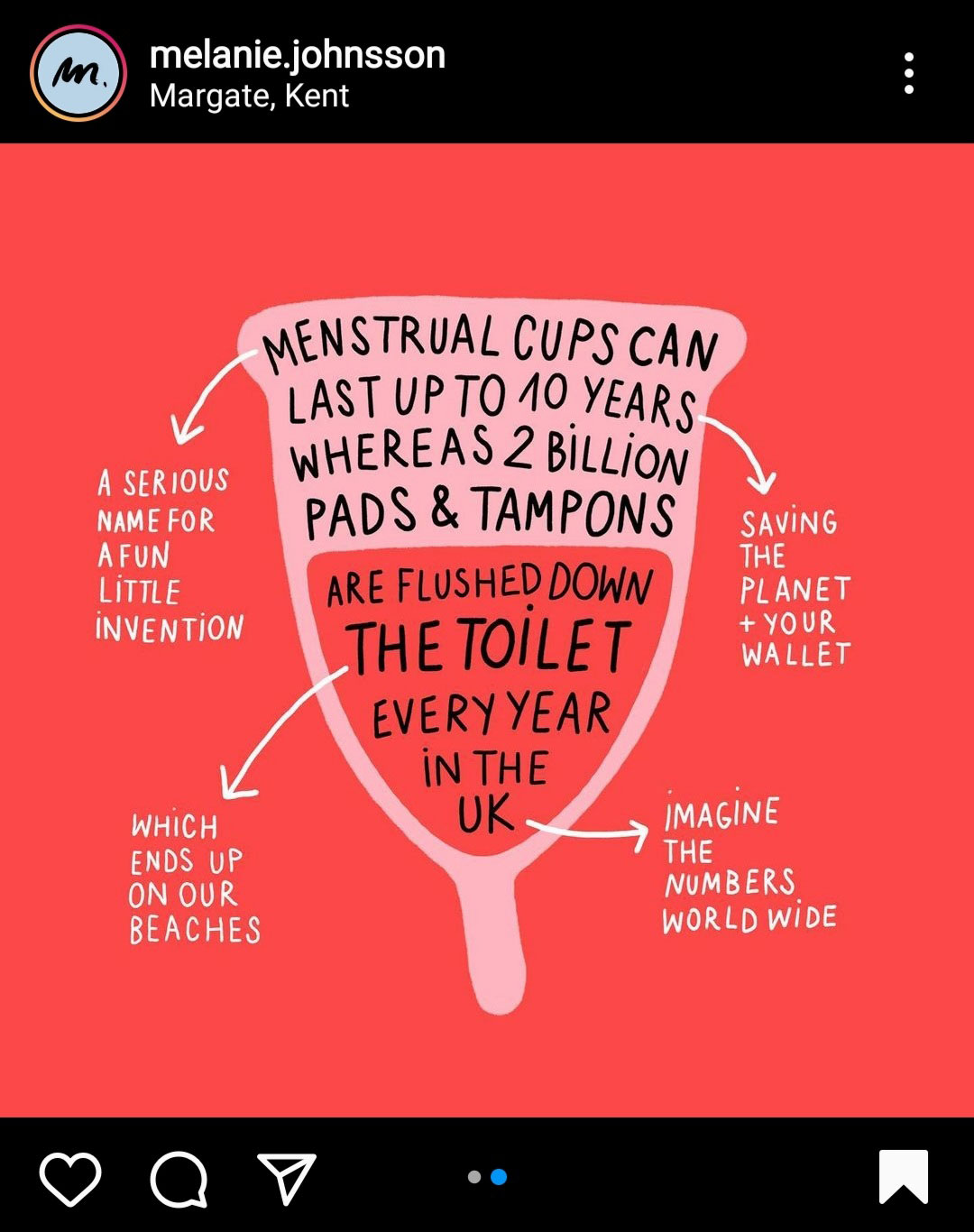
Photo credit: @melanie.johnsson
7. Uniting menstruators in our shared experience...the good, bad, and the BLOODY!
August is a new period care brand founded by Nadya Okamoto. On Instagram, @itsaugust, they share stories from their community in a series entitled #onmyperiod, about what people go through when menstruating. “I still enjoy sex #onmyperiod”, “I have mood swings off and #onmyperiod”, “I poop more #onmyperiod,” are just a few examples. These posts help to normalize different aspects of the experience and bring people together. We all experience the same thing each month after all!
Other posts like the one below help unite us, showing us that as menstruators, we are truly all in this together. No matter where we come from, we are brought together through our menstrual cycles.
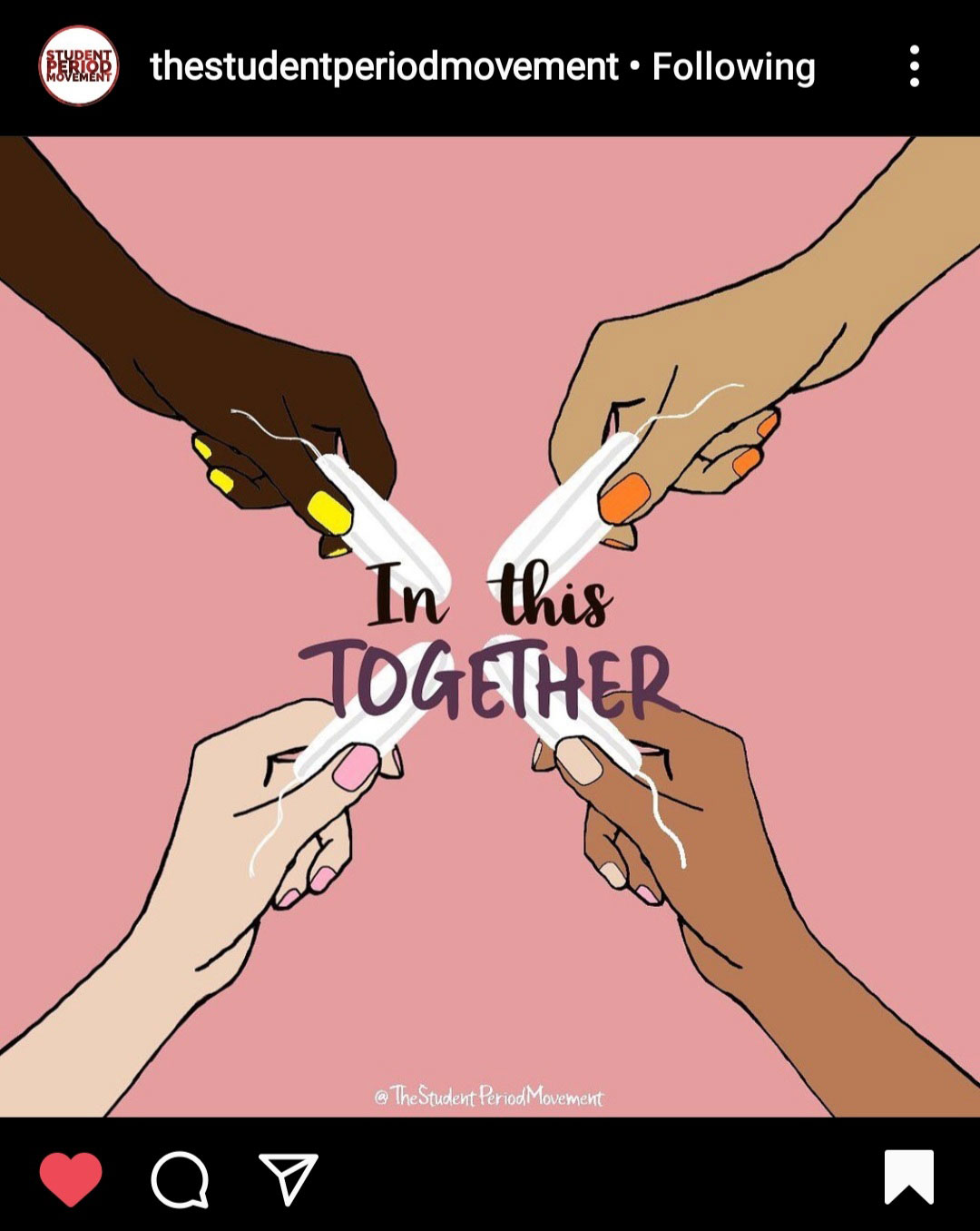
Photo credit: @thestudentperiodmovement
We all know that feeling of anxiety that we’re completely bleeding through our pants when we’re on our period. Here, Sarah Akinterinwa shows in this lovely cartoon how we love to help a sista out.
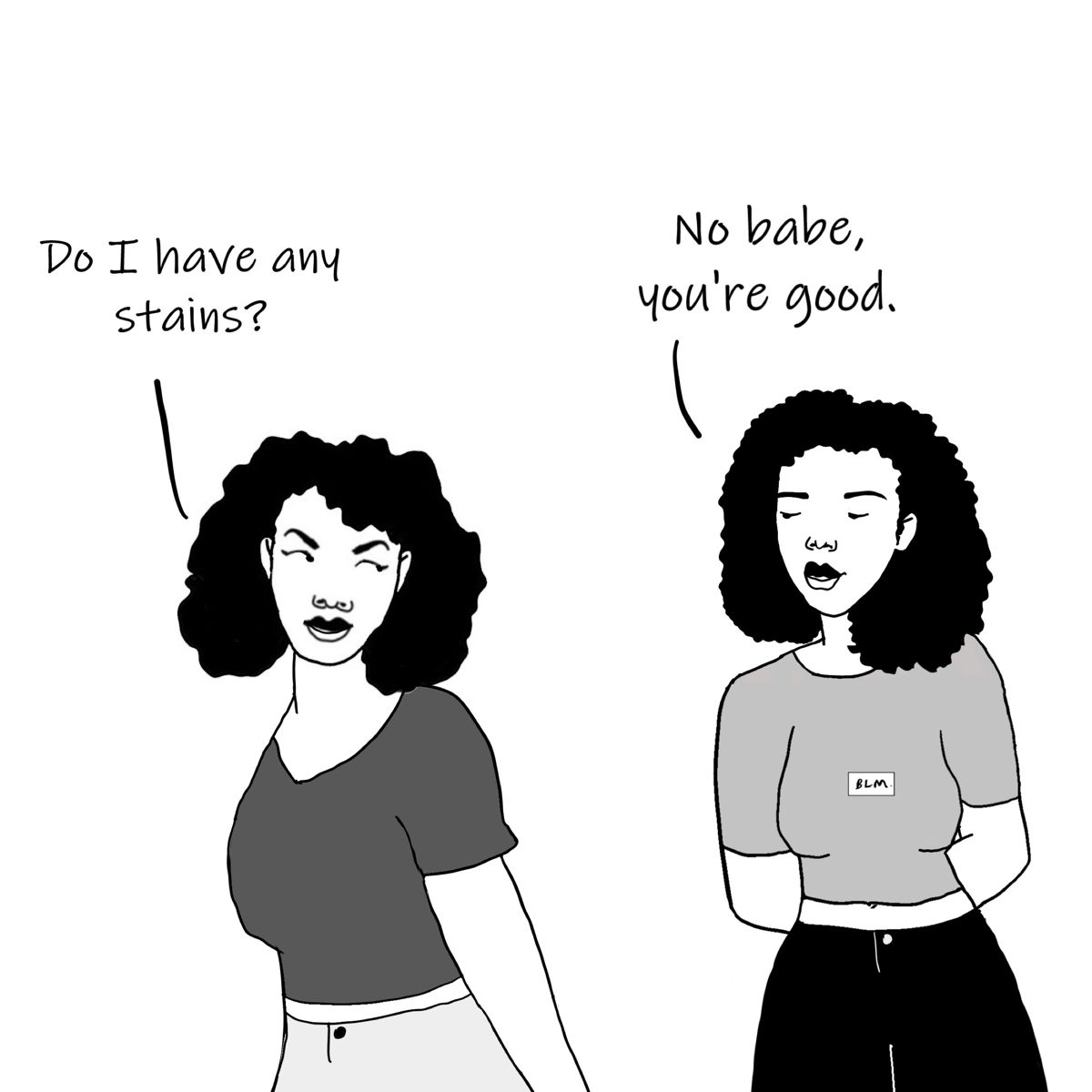
Photo credit: @oyinandkojo
At Your Period Called, we aim to add some fun and humor to the topic of periods with relatable tweets and memes like the one below:
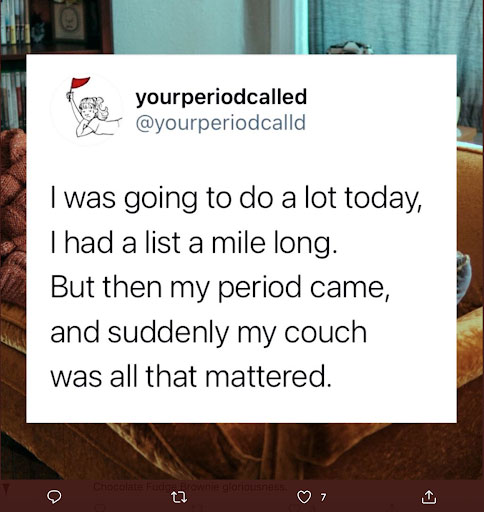
Social media has played a key role in shifting the conversations we’re having around periods. Not only by creating a space to talk about menstruation, but by raising awareness and normalizing the many different aspects of the experience. Let’s continue this amazing momentum by sharing period stories and art to help further break down the period taboo and celebrate the beauty of our cycles.
Kayla is one of our regular writers at Your Period Called, you can read a bit more about her in her bio or take a look at her articles on the history of period taboos and menstrual etiquette.
___________________________
References:
Dean, B. (2021, April 26). Social Network Usage & Growth Statistics: How Many People Use Social Media in 2021? Backlinko. https://backlinko.com/social-media-users
Bobel, C. & Kissling, E. (2011, February 6). Menstruation Matters: Introduction to Representations of the Menstrual Cycle. Women’s Studies. Vol. 40, No. 2. https://www.tandfonline.com/doi/abs/10.1080/00497878.2011.537981.
Dean, B. (2021, April 2). Social Network Usage & Growth Statistics: How Many People Use Social Media in 2021? Backlinko. https://backlinko.com/social-media-users. Accessed April 5, 2021.
Gray, E. (2015, May 27). Instagram’s Removal of Rupi Kaur’s Instagram Photos Shows Us How Terrified We Are Of Periods. Huffington Post. https://www.huffpost.com/entry/rupi-kaur-period-instagram_n_6954898.
Hussain, H. et al. (2017, February 8). The Role of Media in Promoting Strategies for Poverty Eradication. United National Department of Economic and Social Affairs. https://www.un.org/development/desa/dspd/wp-content/uploads/sites/22/2017/02/CSocD55MediaEvent.pdf. Accessed April 9, 2021.
Vagianos, A. (2015, September 1). Woman Told to Kill Herself After Posting Photo of Menstrual Blood on Instagram. Huffington Post. https://www.huffpost.com/entry/woman-told-to-kill-herself-after-posting-photo-of-menstrual-blood-on-instagram_n_55e5d3abe4b0c818f61934fa. Accessed April 5, 2021.
Setoodeh, R. (2015, January 20). ‘Fifty Shades of Grey’ Won’t Include Infamous Tampon Scene. Variety. https://variety.com/2015/film/news/fifty-shades-of-grey-wont-include-infamous-tampon-scene-1201409686/. Accessed April 1, 2021.
Saleh, K. (2021, March 8). Meet the women educating their Instagram followers on female health, one post at a time. Arab News. https://www.arabnews.com/node/1821726/lifestyle. Accessed March 25, 2021.
Rosewarne, L. (2012). Periods in Pop Culture, Menstruation in Film and Television (1 ed.). Lexington Books.
Popular reads on YPC
How to Talk About Your Period With Men
Talking about periods with male friends and co-workers doesn’t have to feel like unleashing landmines.
Read moreWhy and When Did Menstruation Become Taboo?
From the Yukon to Greece, taboos around menstruation have been around for ages and still…
Read moreSocial Media’s Important Role in Reducing Period Stigma
From the explosion of period art, to serving as an activist platform in the menstrual…
Read more